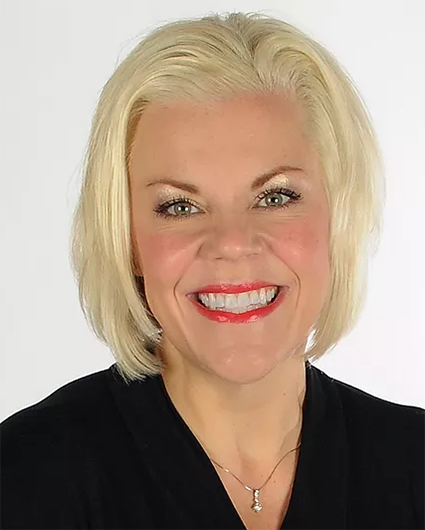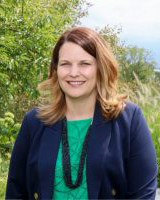Education has been seriously impacted throughout the Metro during the COVID-19 pandemic, especially among families in poverty and families of color.
Local nonprofits say that a lack of access to basic needs, technology issues, social isolation, and mental health struggles have all contributed to learning loss.
Learning Recovery is one of the five focus areas of the Community Resilience Fund, which we launched in April 2021. Anyone can donate to support local nonprofits serving communities disproportionately affected by COVID-19. The first round of funding was recently announced.
Some Students Disappeared from School

Seymour
Nicole Seymour is the executive director of GOALS Center, a local organization that was founded to improve school attendance throughout Douglas and Sarpy Counties. During the pandemic, Seymour worked with other community partners and school social workers from all 11 districts to start a weekly meeting where everyone shared what was going on, where the gaps were, and how they could work together to meet the needs.
On those calls, she heard one of the biggest concerns from social workers: “We can’t find kids.”
Seymour speaks to the need for a collective community response, saying, “It is unrealistic and unfair for school districts to fill that gap between the school building and the community, especially during a pandemic while they were teaching remotely.”
Collectively, GOALS Center and other organizations are doing intentional outreach to find the kids who dropped off.
“It’s a typical thing that some kids stop going to school at the end of the year, but this year it was on a much larger scale,” Seymour said. “Families were fatigued, and there were technical issues with no support.”
Schools are open again and afterschool programming has returned. However, school attendance is nowhere near normal yet, according to GOALS Center. Collective for Youth, the organization that coordinates afterschool programming for Omaha Public Schools (OPS), said that the number of kids attending their programs is not back to what they typically serve, either.
“It is unrealistic and unfair for school districts to fill that gap between the school building and the community, especially during a pandemic while they were teaching remotely.”
Additionally, many of these “lost learners” were testing at below grade level before the pandemic.
“We keep talking about learning loss, but kids had to know the concepts to count as learning loss,” said Megan Addison, executive director of Collective for Youth. “If kids were behind before the pandemic, now you’ve layered that on top.”
Social Support & Wellbeing Became a Crucial Focus

Addison
When schools closed during the pandemic, afterschool programming also moved online. A number of kids couldn’t join because they didn’t have access to a device. Collective for Youth found that a lot of households only had one device and multiple family members who needed it. As a result, students missed out on meaningful social connections.
“Afterschool programs provide kids with context and experience, and last year we weren’t able to provide those enrichment experiences that help them grow,” Addison said. “Middle-class kids were still doing some activities last year, but families without resources got left behind.”
During the pandemic, both afterschool programs and truancy prevention organizations shifted their focus to combatting social isolation and the impact of the pandemic on youth’s mental health and wellbeing.
At GOALS Center, the most overwhelming need is in the area of child wellbeing, with nearly more than half of local families they serve needing support. Those who participate in their program see huge gains for kids’ and families’ wellbeing over the course of a year—an improvement of 57%.
“Middle-class kids were still doing some activities last year, but families without resources got left behind.”
Collective for Youth noticed similar needs and responded accordingly.
“Think of the isolation that kids experienced last year. Our focus has been on providing social and emotional support—having fun,” Addison said.
The Simple Foundation, which focuses on programs for immigrants and refugees, came across situations brought on by the pandemic that required additional tools and training for staff.
“We began to leverage relationships and resources to get mental health support from people who look like us and sound like us,” said Osuman Issaka, president and CEO of The Simple Foundation. “We also hired a mental health counseling company to train our staff. Now everyone has gone through the program so we can identify the signs of depression, simple coping skills, and how to reach out for help.”
Investment into Infrastructure & Workforce is Needed

Issaka
Everyone we spoke with agreed that internet connectivity has been a continual issue that needs to be addressed within the city, especially for families who live in North and South Omaha.
“If I’m driving to pick a kid up, there are areas where I know I will lose connectivity,” Issaka said. “It’s going to happen at 30th and Lake, 30th and Burdette, NW Radial Highway, and in South Omaha. In other places in the city, I have all my bars. What is the reason for that? We need to invest in these areas and understand that we have to do with instead of doing to a community.”
The Omaha metro needs to make a long-term investment into people, too.
Addison speaks to the need to provide better wages and training to our community’s afterschool workforce.
“If we don’t have the staff, we can’t run the programs,” she said.
Afterschool workers labor odd hours at low pay and are not adequately equipped to handle the current social and emotional needs of students. On top of that, afterschool staff suffers from the same connectivity issues that students do since they reflect the population they serve.
“There are areas where I know I will lose connectivity… In other places in the city, I have all my bars. What is the reason for that?”
Issaka added that job skills and workforce development are key. At The Simple Foundation, they’re teaching young immigrants and refugees investment skills and helping them to start construction and event planning businesses. Even during the pandemic, youth in The Simple Foundation’s entrepreneurship program have been saving 50-70% of their paychecks from part-time jobs to be invested in stocks, property, or a business of their own.
“We need to develop entrepreneurship and legacy building skills so people can move from working eight to five and become self-sufficient,” Issaka said.
Getting Back to “Normal” Will Take Time
“Because of higher rates of poverty in OPS, we know that recovery is going to take a lot longer for OPS students,” Addison said. “That’s why OPS is pushing for a two-month summer school for more academic time for recovery.”
The Omaha World-Herald reported approximately 8,600 elementary students signed up to attend summer school in June and July. Citing “staffing challenges,” the district scaled back July’s session to approximately 2,160 students.
Issaka believes three things are needed for organizations working in the area of learning recovery.
“If we can get our hands around technology, educational support, and mental health support, we will be heading in the right direction of what normalcy is.”
Collaboration is the Key to Community Success
A collaborative effort across sectors and throughout the community is needed to make an impact on learning now.
“We can’t do this without the community at the table,” Seymour said. “Once people hear about the need, I see so much passion to serve. I know we can do better. we just need to share information and work together if we want to do right by our kids.”
Give to the Community Resilience Fund
We invite you to learn more about the Community Resilience Fund and support the ongoing work of nonprofits to meet local learning recovery needs caused and exacerbated by the COVID-19 pandemic.
READ MORE
How the Pandemic Has Impacted Our Community’s Mental Health
COVID-19 Magnified Omaha’s Housing Issues
Community Resilience Fund Awards Over $100K for COVID Recovery